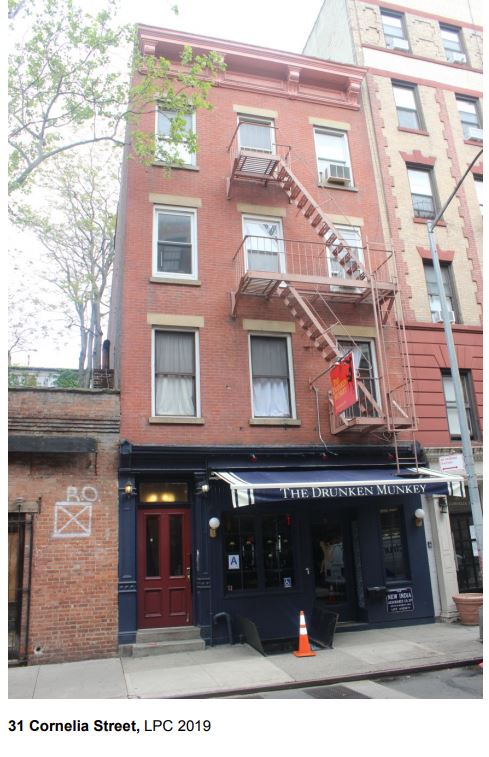
Item 1
LP – 2635
BOROUGH OF MANHATTAN
CAFFE CINO – 31 CORNELIA STREET
On the eve of the 50th Anniversary of the Stonewall Riots and during the first week of Pride Month, HDC is thrilled that the Landmarks Commission dedicated substantial time and resources to designate sites of LGBTQ significance. This community is deeply woven into the fabric of New York, and deserves recognition. It is our hope that these designations will serve as future inspiration and as models to other cities across the country to embrace and celebrate LGBTQ heritage sites, particularly in locales where these communities remain ostracized. The NYC LGBT Historic Sites project has done a tremendous job of documenting scores of places citywide, and we hope that the Landmarks Commission will designate more sites in the future, particularly the Leaves of Grass House at 99 Ryerson Street in Brooklyn.
HDC supports the designation of the Caffe Cino as an Individual Landmark. While the structure itself is already protected as part of the Greenwich Village Historic District, this designation would more intentionally acknowledge and honor this site’s cultural and historical significance to our city, which is considered the birthplace of Off Off Broadway Theater. More importantly, it provided a space where an artistic community could emerge and depict homosexuality in theater, which was illegal at the time. Caffe Cino was listed on the National Register of Historic Places in 2017 for its cultural significance and designation as an Individual Landmark brings deserved visibility to this former venue.
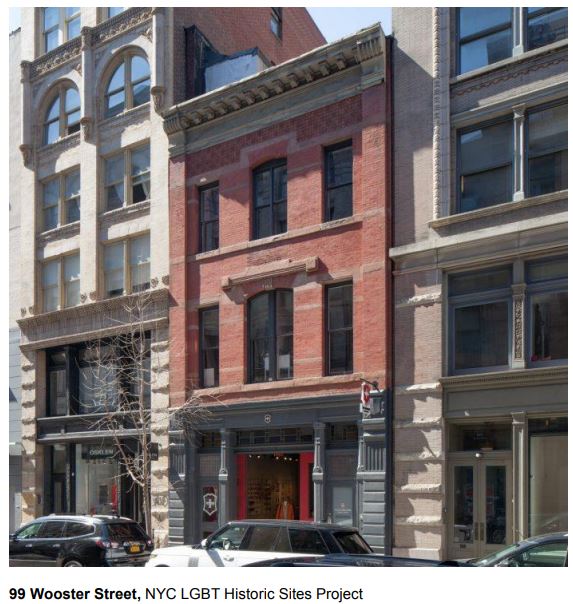
Item 2
LP – 2632
BOROUGH OF MANHATTAN
GAY ACTIVISTS ALLIANCE FIREHOUSE – 99 Wooster Street
HDC supports the designation of the Gay Activists Alliance Firehouse as an Individual Landmark. Having served as the headquarters for America’s most influential gay liberation political activist organization in the 1970’s, this former 1850’s firehouse at 99 Wooster Street holds significant cultural and historical value for our city. From within the walls of this historic firehouse, the Gay Activists Alliance (GAA) worked to advance LGBT civil and social rights by lobbying for the passage of local legislation and planning countless sit-ins and picket line protests.
The Gay Activists Alliance was the first LGBT organization to adopt the lambda as a symbol representing gay rights, thus the symbol was prominently displayed in a large round shield on the exterior of the firehouse. As they and the firehouse were representative of a criminalized population, the GAA experienced harassment and, most notably, an arson fire that largely destroyed the interior of the firehouse in 1973.
The Gay Activists Alliance Firehouse also served as a community center and gathering place for a number of lesbian, gay, and cultural organizations, hosting social events, dances, and a movie series titled “Firehouse Flicks”. The instrumental role that this structure has played in not only the facilitating of LGBT activism, but also the strengthening of our city’s LGBT communities, is undeniable. Activists and members of the gay community actively put themselves at risk by congregating in this space and by fighting institutional discrimination together.
Sites such as the Gay Activists Alliance Firehouse and the movements ignited from within them are integral to the diverse story of New York City’s past. Protecting the physical spaces that embody the civil rights and social justice history of our city is a crucial task with which the Landmarks Commission is charged. This landmark designation would not only acknowledge the architectural significance of this structure, but would also intentionally honor this site as one of New York City’s first formalized LGBT community spaces and as a physical embodiment of the risks that activists took to fight for equality.
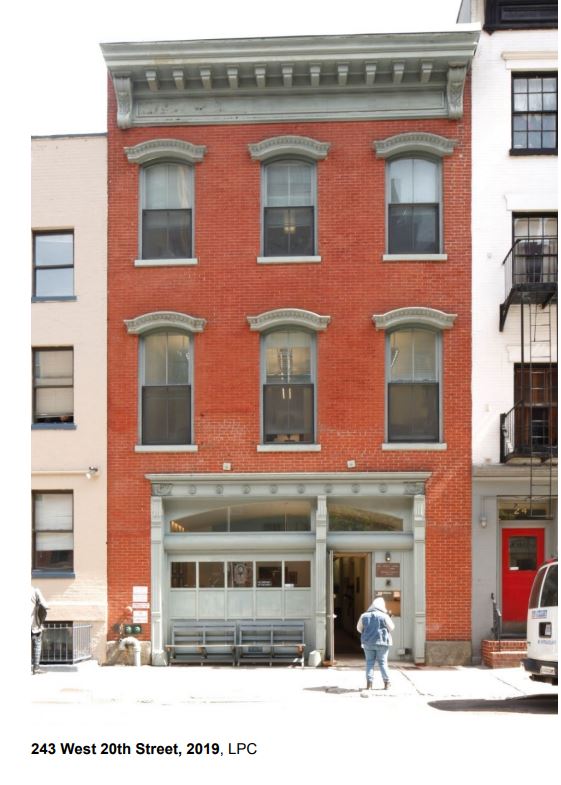
Item 3
LP – 2633
BOROUGH OF MANHATTAN
WOMEN’S LIBERATION CENTER – 243 WEST 20TH STREET
The Historic Districts Council is thrilled to support the designation of the Women’s Liberation Center, which, not only being culturally significant as a LGBTQ site, served as a hotbed of the Women’s Liberation Movement. Numerous lesbian activist groups called this building home, but most famously the Lesbian Feminist Liberation (LFL) moved here in 1973. One of the primary issues LFL confronted was the custody of children of lesbian divorcees. Well into the 1980s, “When lesbian mothers…came out in the process of a divorce from heterosexual spouses, they often faced the immediate danger of losing custody and even contact with their children.”
The origins of marriage equality actually began with custody rights for gay parents. Issues of custody “…played a fundamental role in turning the focus of the LGBT freedom struggle toward the rights of marriage and the family” and issues of the family remain at the heart of the LGBTQ community’s path to equality. Only in 2011 did New York State legalize gay marriage, and more than half of the States in our Union (thirty) still legally discriminate against LGBTQ people.
As it has recently come to light, of the 150 outdoor public monuments in New York, only five are female. It is magnificent that the Landmarks Commission will officially designate a landmark that honors women; women who fought hard to shape and change women’s role and the role of the family in society for the better. There is more work to do, as women’s cultural significance remains publicly faceless, and the five monuments are a sobering reminder of this. The City will erect four new monuments honoring women, and we urge the LPC to explore more potential landmark sites to enshrine women’s contributions to the City.

Item 4
LP – 2634
BOROUGH OF MANHATTAN
THE LGBT COMMUNITY CENTER – 208 WEST 13TH STREET
HDC enthusiastically supports the designation of The LGBT Community Center. It can be argued that The Center is more than just a gathering hub, but a longtime essential support system for the LGBT residents of New York City that has provided resources and safe meeting spaces for countless community organizations and activist groups since 1984. Founded before the passing of the Gay Rights Bill that banned discrimination based on sexual orientation in housing and employment, its original Vice President stated that The Center “will give us an independence outside of political control with the community determining its needs.”
Hosting cultural programs and speaker events, which brought well-known LGBT figures such as Audre Lorde and Quentin Crisp to meet with members of the lesbian and gay community, the historic building at 208 West 13th Street was a haven for a criminalized population that regularly experienced institutional discrimination. Of the many groups to call The Center home, the Coalition for Lesbian and Gay Rights famously worked to promote the Gay Rights Bill through demonstrations and were considered to be instrumental in the New York City Council’s passing of the bill in 1986. Additionally, The Center served as a space of remembrance, memorializing those lost to the AIDS crisis and commemorating the 20th anniversary of Stonewall through an expansive art installation.
Though the building had operated under many names before being bought by the founders of The Center in 1983, the Italianate-style building was originally known as Ninth Ward School No. 16 after being erected in 1869. According to its designation report, the building then continued to expand “to meet the growing needs of the community”, and so it is fitting to designate The LGBT Community Center as a significant site that is and has historically been a valuable asset to our city’s diverse communities.
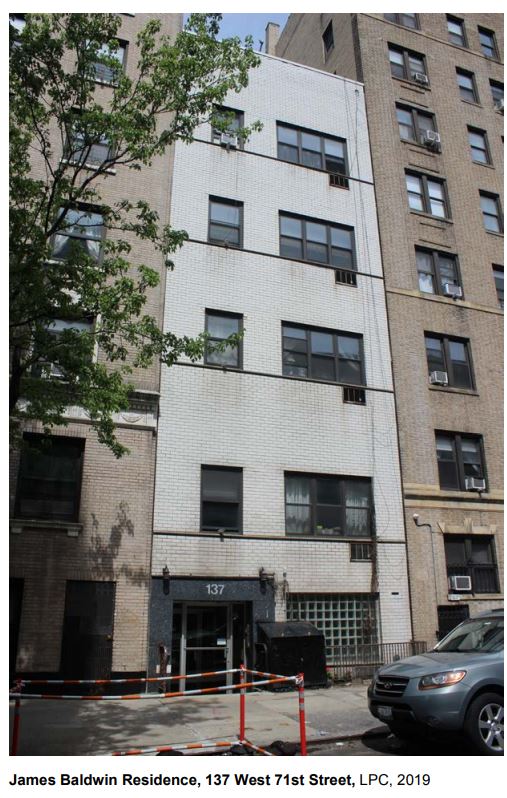
Item 5
LP – 2636
BOROUGH OF MANHATTAN
JAMES BALDWIN RESIDENCE – 137 WEST 71st STREET
The Historic Districts Council enthusiastically supports recognizing author James Baldwin’s home on West 71st Street as an individual landmark. Baldwin’s literary contributions gave identity to and empowered the voices of African-Americans during the turbulent 1960s, when movements for society’s marginalized were crystallizing. His depictions of bi-sexual and same-sex relationships in his works were groundbreaking, and his exploration of interracial relationships was extremely controversial. His works are the embodiment of the societal changes that took place during that decade. With all of that being said, HDC is pleased that the LPC will regulate this building based on its period of significance of the early 1960s when Baldwin lived here. The 1961 alteration to this former brownstone is symbolic of the radical break from the past and representative of the change that artists like Baldwin were instrumental in shaping.
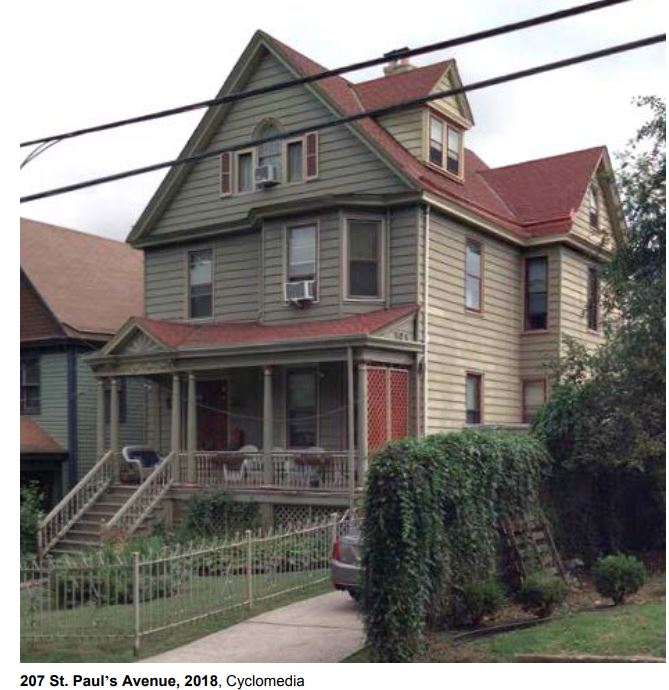
Item 6
LP – 2642
BOROUGH OF STATEN ISLAND
AUDRE LORDE RESIDENCE – 207 ST. PAUL’S AVENUE
The Historic Districts Council eagerly supports the designation of the Audre Lorde Residence. Having served as the former home of the influential writer, scholar, and civil rights activist Audre Lorde from 1972 to 1987, 207 St. Paul’s Avenue is culturally and historically significant in a great number of ways.
Writing as a black lesbian feminist, Audre Lorde and her internationally renowned body of work spoke largely to the discriminatory injustices faced by the LGBT community and women of color, and as such, she was a prominent voice in the civil rights and liberation movements of the 1970’s. Having once said, “I write for those women who do not speak, for those who do not have a voice because they were so terrified, because we are taught to respect fear more than ourselves”, Lorde’s activism and published works openly challenged institutional sexism and racism.
While living at this residence, Lorde authored many of her notable works such as The Black Unicorn and Zami: A New Spelling of My Name, co-founded Kitchen Table: Women of Color Press which exclusively published works by and about women of color, spoke at the National March on Washington for Lesbian and Gay Rights in 1979, and held the distinguished position of Thomas Hunter Chair of Literature at Hunter College.
Audre Lorde was officially named Poet Laureate of New York State during her final year living at this residence; further strengthening the significant link between this 1898 home and her inspiring legacy, all the more justifying the call for its designation.



